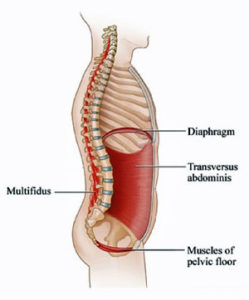What would I do without Alison Smith’s deep knowledge of the body she imparts during her weekly yoga classes in Mill Valley and San Francisco? She has helped me become strong and stable in my body. A lot of this has to do with her focus on core strength. In the following article Alison describes why Deep Core work is essential for keeping in tip-top shape, injury-free no matter what your age or ability. You may find out more about Alison’s classes, retreats and newsletters at www.AlisonSmithYoga.com
![]()
 During the last few weeks of classes, we’ve been exploring the bandhas. These are often referenced and rarely explained in modern postural yoga. So…
During the last few weeks of classes, we’ve been exploring the bandhas. These are often referenced and rarely explained in modern postural yoga. So…
What are the Bandhas? What are the Deep Core muscles? Are they the same?
Yes and No.
The Yoga Tradition urges you deeper than just muscles and bones, and while the bandhas correlate to what I’ll call the Deep Core, they are also an energetic experience and subtle body awareness that is more than their physical counterpart.
Specifically, the Deep Core muscles are the pelvic floor, multifidi, transverse abdominis and deep neck flexors. The (common) Bandhas are Mulabandha, Uddiyana Bandha and Jalandhara Bandha.
Mula means “Root” and Bandha can be translated to lock, seal, or link. The Root Link of Mula Bandha has a relationship to the pelvic floor and multifidi of the Deep Core.
The Pelvic Floor is the musculature at the base of your torso. Think of it this way: There is no bone between your lower ribs and pelvis other than your spine. Yet something holds your organs in place. That “something” is the abdominals. The abdominals are like a basketweave and the Pelvic Floor is the bottom of that basket.
Your pelvic floor is considered a “diaphragm” and has a responsive, springy, trampoline-like quality. It is made up of the levator ani muscles which look like hammocks strung across the pelvis.
On the mat, Mulabandha is most commonly associated with lightness and lift. It’s the spring from Down Dog to the top of your mat. It’s the power that lifts you up in Lolasana. It also provides a stabilizing hug for your lower back when backbending or twisting. It feels like leg-lengthening and spine draping in forward folds. It’s the sense of center in balance poses.
The bandhas create sustainaiblity by providing deep support. They also aid in the growth of your practice by asking you to dive deeper and explore more subtle realms. For more about Mulabandha, including the specific muscles and exercises to feel it, click here:
![]()
Want to learn and grow your practice this year?
The upcoming local retreats have a few spaces left. Retreats include in-depth practices, morning meditation, and “office hours” for questions and individual attention. If you can’t carve out the time for retreats, the Fall Semester of Yoga Club will start in September.
Summer Retreat: Find Your Wings
What propels your practice forward? In Patanjali’s Yoga Sutras, there are 2 essential qualities for progress on the path. Abhyasa (persistent effort) and Vairagya (non-attachment). They are like wings – with just 1 flapping, you can’t say in the air. When working together, you’ll glide gracefully to new heights. The Summer yoga retreat will focus on finding your wings. You’ll cultivate inner strength and perseverance while being supported to let go and release.
![]()
Read my Yoga and Stretch post for a daily program that can fit into 20 minutes or more depending on your schedule. And my article “Inversions Make You Smarter” is an informative how-to on increasing blood flow to the brain.
Leave a Reply